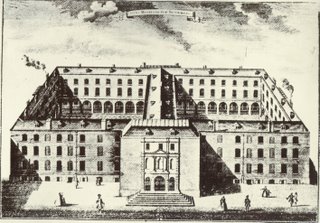Medical Heritage at Guy's Meeting

We attended a meeting called by Simon Howell of King's College to discuss setting up a Medical Heritage of Guy's project. My version of the idea - see below - was circulated, and there was lots of enthusiasm for the idea from a number of important collections although I think the people from Guy's people are more interested in beautifying Guy's courtyard, and finding a use for the 'heritage' buildings.
Celebrating the Medical Heritage of the Guys/Old St Thomas Hospital area
Introduction
Recent discussions have been held on the importance of the Guys/Old St Thomas's area for the history of Medicine. The area is of particular importance for the history of medicine in London and, as the Capital, of Britain but also has an important place in the story of the history of Western Medicine.
The importance of the vicinity suggests a scheme or schemes to celebrate and preserve the medical heritage of the area would be appropriate. Two factors make this an opportune time to begin work on a scheme.
Firstly, St Thomas Church, and the Old Treasurer's House (now Collegiate House) has been put on the market. This not only provides a chance to acquire the last remaining part of Old St Thomas Hospital for public use but will also remove the risk of closure of the Old Operating Theatre Museum in the event of a purchase by an unsympathetic new landlord.
Secondly, current plans at Guys suggest that buildings of the courtyard of Old Guys House are to be vacated in due course (2010/12).
Interested Parties
On January 19th a meeting has been arranged by Professor Simon Howell of the Kings College School of Medicine, which owns the buildings in the Courtyard. Interested parties will discuss possible cooperation on a scheme to use the buildings to provide an important public facility covering the history of medicine and to encourage public engagement in medical science.
The meeting will include representatives of Guys and St Thomas Charity, Southwark Cathedral, the Gordon Museum, the Florence Nightingale Museum, the Old Operating Theatre Museum, the Royal Bethlem Hospital Museum and Archives, and the Royal Pharmaceutical Society amongst others.
Although discussions are just beginning reactions to the scheme have been very positive with responses ranging from possible interest in moving entire collections to the site to interest in having an outstation/presence on the Guys campus. It is possible to envisage a scheme which contains significant collections from medical history, and a facility/exhibition designed to engage the public in the present and future of medicine which could act as the public face of the Kings/Guys Complex. The centre piece would be in Old Guys House with links to local heritage sites such as Guys Chapel, Gordon Museum, St Thomas Church, the Old Operating Theatre, and Southwark Cathedral.
The above report was written for the Old Operating Theatre Museum and does not necessarily represent the views of any other party mentioned above.
Appendix 1
The Medical Heritage
The area around St Thomas St. contains the following important medical sites:
1.Old St Thomas Hospital was described as being 'ancient' in 1215, is at least the 2nd oldest hospital in London - with St Barts, world famous in medical history. Although the hospital moved from the site in 1862 surviving buildings of Old St Thomas Hospital include::
1.St Thomas Church – rebuilt in 1703 and the Parish Church of the Hospital from its foundation. A Grade 2* listed property.
2.the Treasurer's House – a Grade 2* listed property which was one of the main entrance into the Hospital
3.the Old Operating Theatre Museum and Herb Garret – a unique survival of international importance
4.A range of 18th Century buildings built by the Hospital, including the Apothecary's House.
2.Guy's Hospital - 18th Century Hospital originally founded for the 'incurable ill and the hopelessly insane' and which includes historic elements:
1.the surviving Quadrangles of Old Guy's House
2.Guys Chapel
3.the Gordon Museum
3.St Thomas's Street
1.originally a street of houses mostly occupied by the Medical Profession and instrument makers
2.the site of the house where Keats stayed while studying to be a surgeon at Guys
4.Southwark Cathedral – the Priory of St Mary Overy was the mother church of St Thomas Hospital and can be considered to be the foundation upon which 900 years of health care has sprung. The Church was founded or re founded in 1100AD. A statue of Aesculapius was found near the Cathedral hinting at a possible origin of health care in London going back to the Roman period.
5.Outliers and nearby sites
1.Evelina Children's Hospital – Britain's first hospital dedicated to children was founded 26th June 1869 Southwark Bridge Road
2.Borough Market – providing food for London since the medieval period
3.Sites/Buildings of Poor Law Workhouses in nearby Parishes – providing rudimentary health care for inmates
4.Model housing – Historic Southwark has a wealth of early philanthropic housing schemes designed to improve the health of working class residents. Two examples are in Redcross Street - the Octavia Hill's Red Cross Cottages and the Cromwell Buildings built by the the Industrial Dwellings Society
Comments